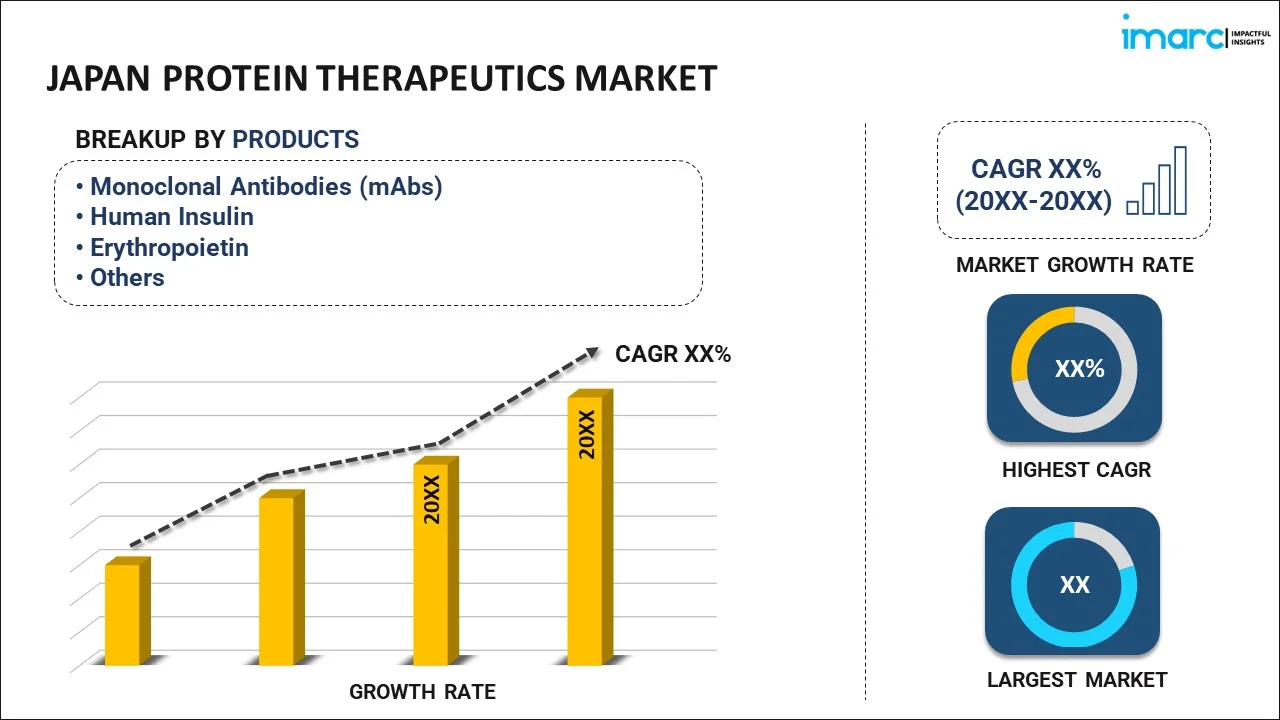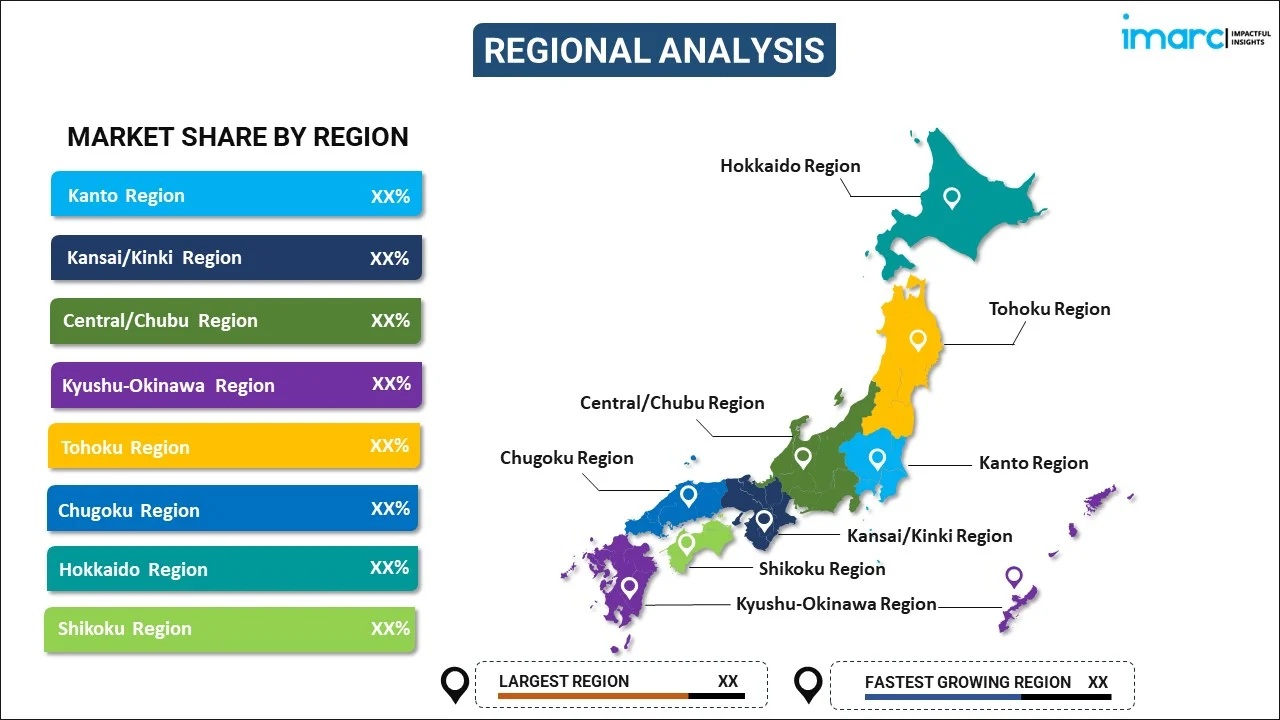
Japan Protein Therapeutics Market Report by Product (Monoclonal Antibodies (mAbs), Human Insulin, Erythropoietin, Clotting Factors, Fusion Protein, and Others), Therapy Area (Metabolic Disorders, Immunological Disorders, Hematological Disorders, Cancer, Hormonal Disorders, Genetic Disorders, and Others), Function (Enzymatic and Regulatory Activity, Special Targeting Activity, Vaccines, Protein Diagnostics), and Region 2025-2033
Market Overview:
Japan protein therapeutics market size reached USD 30.3 Billion in 2024. Looking forward, IMARC Group expects the market to reach USD 53.8 Billion by 2033, exhibiting a growth rate (CAGR) of 6.27% during 2025-2033. The rising incidence of chronic diseases such as cancer, diabetes, and autoimmune disorders, which has led to an increased demand for protein therapeutics to provide targeted and effective treatment, is driving the market.
|
Report Attribute
|
Key Statistics
|
|---|---|
|
Base Year
|
2024 |
|
Forecast Years
|
2025-2033 |
|
Historical Years
|
2019-2024
|
| Market Size in 2024 | USD 30.3 Billion |
| Market Forecast in 2033 | USD 53.8 Billion |
| Market Growth Rate (2025-2033) | 6.27% |
Protein therapeutics refers to a class of medical treatments that utilize proteins, typically biologically derived molecules, to prevent, manage, or cure various diseases and medical conditions. These therapeutic proteins can include antibodies, enzymes, hormones, or other functional proteins that play crucial roles in the body's biological processes. Protein therapeutics are designed to target specific disease mechanisms, such as binding to cancer cells or modulating immune responses, offering a high degree of precision and reduced side effects compared to traditional pharmaceuticals. They are often produced using biotechnology techniques, including recombinant DNA technology, and can be administered through injections, infusions, or other delivery methods. Examples of protein therapeutics include monoclonal antibodies used to treat autoimmune diseases like rheumatoid arthritis, insulin for diabetes management, and clotting factors for hemophilia. These therapies have revolutionized medicine, providing effective treatments for a wide range of diseases while continually advancing through ongoing research and development efforts.
Japan Protein Therapeutics Market Trends:
The protein therapeutics market in Japan is thriving due to several key drivers that have propelled its growth. Firstly, advancements in biotechnology have opened up new avenues for the development of protein-based drugs. This is exemplified by the increasing use of recombinant DNA technology, which allows for the production of therapeutic proteins with enhanced specificity and efficacy. Furthermore, the rising prevalence of chronic diseases, such as cancer, diabetes, and autoimmune disorders, has driven the demand for innovative treatment options. As a result, pharmaceutical companies are investing heavily in R&D to create novel protein therapeutics targeting these diseases. Additionally, the aging regional population is a significant driver of the protein therapeutics market. With a growing elderly population, there is an increased need for therapies that can address age-related conditions, further bolstering the demand for protein-based drugs. Moreover, the emerging trend toward personalized medicine that tailors treatments to individual patients is expected to drive the protein therapeutics market in Japan during the forecast period.
Japan Protein Therapeutics Market Segmentation:
IMARC Group provides an analysis of the key trends in each segment of the market, along with forecasts at the country level for 2025-2033. Our report has categorized the market based on product, therapy area, and function.
Product Insights:

- Monoclonal Antibodies (mAbs)
- Human Insulin
- Erythropoietin
- Clotting Factors
- Fusion Protein
- Others
The report has provided a detailed breakup and analysis of the market based on the product. This includes monoclonal antibodies (mAbs), human insulin, erythropoietin, clotting factors, fusion protein, and others.
Therapy Area Insights:
- Metabolic Disorders
- Immunological Disorders
- Hematological Disorders
- Cancer
- Hormonal Disorders
- Genetic Disorders
- Others
A detailed breakup and analysis of the market based on the therapy area have also been provided in the report. This includes metabolic disorders, immunological disorders, hematological disorders, cancer, hormonal disorders, genetic disorders, and others.
Function Insights:
- Enzymatic and Regulatory Activity
- Special Targeting Activity
- Vaccines
- Protein Diagnostics
The report has provided a detailed breakup and analysis of the market based on the function. This includes enzymatic and regulatory activity, special targeting activity, vaccines, and protein diagnostics.
Regional Insights:

- Kanto Region
- Kansai/Kinki Region
- Central/ Chubu Region
- Kyushu-Okinawa Region
- Tohoku Region
- Chugoku Region
- Hokkaido Region
- Shikoku Region
The report has also provided a comprehensive analysis of all the major regional markets, which include Kanto Region, Kansai/Kinki Region, Central/ Chubu Region, Kyushu-Okinawa Region, Tohoku Region, Chugoku Region, Hokkaido Region, and Shikoku Region.
Competitive Landscape:
The market research report has also provided a comprehensive analysis of the competitive landscape. Competitive analysis such as market structure, key player positioning, top winning strategies, competitive dashboard, and company evaluation quadrant has been covered in the report. Also, detailed profiles of all major companies have been provided.
Japan Protein Therapeutics Market Report Coverage:
| Report Features | Details |
|---|---|
| Base Year of the Analysis | 2024 |
| Historical Period | 2019-2024 |
| Forecast Period | 2025-2033 |
| Units | Billion USD |
| Scope of the Report | Exploration of Historical Trends and Market Outlook, Industry Catalysts and Challenges, Segment-Wise Historical and Future Market Assessment:
|
| Products Covered | Monoclonal Antibodies (mAbs), Human Insulin, Erythropoietin, Clotting Factors, Fusion Protein, Others |
| Therapy Areas Covered | Metabolic Disorders, Immunological Disorders, Hematological Disorders, Cancer, Hormonal Disorders, Genetic Disorders, Others |
| Functions Covered | Enzymatic and Regulatory Activity, Special Targeting Activity, Vaccines, Protein Diagnostics |
| Regions Covered | Kanto Region, Kansai/Kinki Region, Central/ Chubu Region, Kyushu-Okinawa Region, Tohoku Region, Chugoku Region, Hokkaido Region, Shikoku Region |
| Customization Scope | 10% Free Customization |
| Post-Sale Analyst Support | 10-12 Weeks |
| Delivery Format | PDF and Excel through Email (We can also provide the editable version of the report in PPT/Word format on special request) |
Key Questions Answered in This Report:
- How has the Japan protein therapeutics market performed so far and how will it perform in the coming years?
- What has been the impact of COVID-19 on the Japan protein therapeutics market?
- What is the breakup of the Japan protein therapeutics market on the basis of product?
- What is the breakup of the Japan protein therapeutics market on the basis of therapy area?
- What is the breakup of the Japan protein therapeutics market on the basis of function?
- What are the various stages in the value chain of the Japan protein therapeutics market?
- What are the key driving factors and challenges in the Japan protein therapeutics?
- What is the structure of the Japan protein therapeutics market and who are the key players?
- What is the degree of competition in the Japan protein therapeutics market?
Key Benefits for Stakeholders:
- IMARC’s industry report offers a comprehensive quantitative analysis of various market segments, historical and current market trends, market forecasts, and dynamics of the Japan protein therapeutics market from 2019-2033.
- The research report provides the latest information on the market drivers, challenges, and opportunities in the Japan protein therapeutics market.
- Porter's five forces analysis assist stakeholders in assessing the impact of new entrants, competitive rivalry, supplier power, buyer power, and the threat of substitution. It helps stakeholders to analyze the level of competition within the Japan protein therapeutics industry and its attractiveness.
- Competitive landscape allows stakeholders to understand their competitive environment and provides an insight into the current positions of key players in the market.
Need more help?
- Speak to our experienced analysts for insights on the current market scenarios.
- Include additional segments and countries to customize the report as per your requirement.
- Gain an unparalleled competitive advantage in your domain by understanding how to utilize the report and positively impacting your operations and revenue.
- For further assistance, please connect with our analysts.
 Inquire Before Buying
Inquire Before Buying
 Speak to an Analyst
Speak to an Analyst
 Request Brochure
Request Brochure
 Request Customization
Request Customization




.webp)




.webp)












